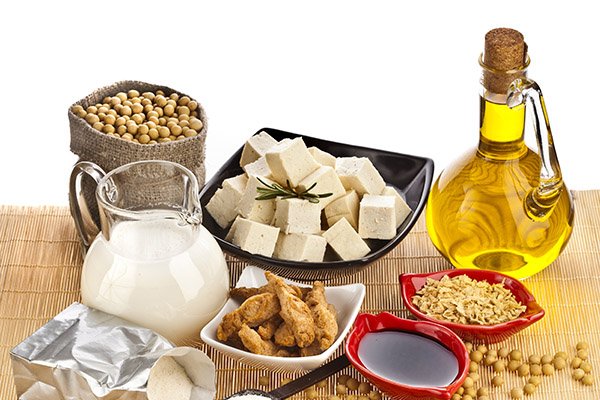Ounce for ounce, there’s no other single food that supplies as much nutritional value as the soybean, which is not only a good source of protein but also calcium, fiber, folic acid, potassium, unsaturated fats, vitamins D and B12, and zinc.
Soy is the only plant-based complete protein containing all the essential amino acids animal proteins provide, needed by the body and may improve bone health and cognitive function. It’s the only plant protein that carries the U.S. Food and Drug Administration’s (FDA) heart health claim confirming it may be able to reduce the risk of coronary heart disease. Soybean oil, which is typically labeled as “vegetable oil”, also carries a qualified FDA heart health claim confirming it may be able to reduce the risk of coronary heart disease.
Soybeans are the richest source of isoflavones, which may reduce the risk of heart disease, protect against some cancers, and maintain strong bones. Consuming 25 grams per day of soy foods has been shown to lower LDL (bad) cholesterol in the blood and lower the risk of coronary heart disease, the leading cause of death in the U.S. Soy is naturally cholesterol free and rich in omega-3 fatty acids, which positively impact heart health.
Soy stabilizes blood sugar levels, increases blood circulation, aids digestion, and can help you lose weight. A serving of soy foods can provide as much as a quarter of the daily protein requirements for an average adult.
Soybeans have been cultivated in North America longer than the U.S. has been a nation. The first soybean on the continent was planted in Georgia in 1765, 11 years before 13 fledgling colonies declared their independence from Great Britain.
The U.S. is the top soybean producer in the world, and it is currently grown on more acres in Kentucky than any other crop.
Soybeans are the second-largest U.S. agricultural export, trailing only corn. American farmers account for more 90 percent of the world’s soybean exports. Ironically, most of them are imported by China, where the crop originated around 7000 B.C.
While soy has been consumed for thousands of years in many East Asian countries, it wasn't until the late 20th century that it began to emerge as a food source in America. Common types of soy foods include:
Veggie burgers (including Burger King’s Impossible Burger) made from tofu, tempeh, and other soy-based meat alternatives;
Imitation dairy products (milk, cheese, and yogurt) made from soy;
Edamame (immature green soybeans in the pod), roasted soy nuts (mature beans), and bean sprouts; and
Soy protein bars, perfect for post-workout recovery.
Five Ways to Benefit from Soy Foods
Cook with soy foods: Incorporate soy foods like tofu, edamame, tempeh, soymilk, and soy-based meat alternatives in your cooking. Try dietitian-endorsed recipes like Basil Lime Edamame Toast for a snack, or Caribbean Crispy Tofu Pineapple Bowls for dinner.
Try flexitarian (pair plant and animal protein): Add crispy tofu and fresh edamame to chicken, beef, pork or shrimp stir fry dishes for a protein and isoflavone boost (powerful plant compounds naturally found in soybeans) that may help reduce breast and prostate cancer risk and lower cholesterol.
Eat fermented soy foods to support gut health: Good bacteria found in soy foods, especially those that are fermented like miso and natto, may help promote a healthier gut. Dietary fiber also supports digestive health, so choose fiber-rich soy foods like edamame or soy nuts.
Look for soy on the label: Most vegetable oil on store shelves is 100% soybean oil. Soybean oil is recognized for its heart health benefits, and it also has a neutral flavor and high-heat cooking stability, making it an excellent choice for frying, baking, sautéing, and more.
Shop your local grocery store: You can find a selection of soy foods and ingredients in your local store. Edamame, tofu, soy nuts, soy nut butter, soy milk, soy-based yogurt and cheese, tempeh, miso, soy-based protein bars and powders, soy-based meat alternatives, and more. Every store is a little bit different, so if you can’t find soy foods in the store, check the health foods aisle or section.
Articles
False Health Claims About Seed Oils
April is National Soy Foods Month
Soy Recipes
Farmer Profiles
Luttrell Farms
Darren Luttrell, the third generation on this land, always knew he wanted to farm and has made it his living since he was 15 years old. Forty years later, he still enjoys farming life very much. Darren raises corn, soybeans, and commercial chickens for Perdue Farms. You may have seen the Perdue label on chicken at your grocery store. Darren said he is also going to start growing rapeseed for Perdue chicken feed. http://luttrellfarms.weebly.com/
Affinity Farms
Affinity Farms is operated by the Pottinger Family in Nelson, LaRue, and Hardin Counties, but New Haven is their home. They grow corn, soybeans, and wheat. https://www.facebook.com/AffinityFarms/
Lawson Family Farm
“Nathan and Wanda Lawson’s family farms in Spencer and northern Nelson County, Kentucky, where they raise beef cattle, corn, soybeans, and their four kids. They farm just over 900 acres where they run 125 head of momma cows and background cattle.” - Source The Lawsons partner with Kentucky Cattleman’s Association so that their products stay in state and support the local community.
https://www.facebook.com/LawsonFarmsKy/









